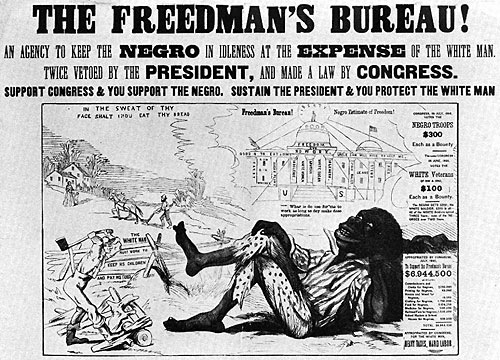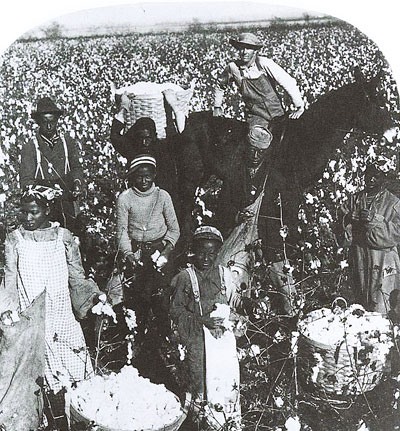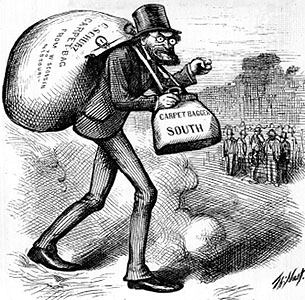The New South
An important piece of the Reconstruction era was the establishment of a system to educate African Americans who had been denied access to learning. The first Morrill Act in 1862 made education available to some African Americans. However, it was not until the Freedman’s Bureau was founded in 1872 that Historically Black Colleges and Universities (HBCUs) opened their doors to former slaves and children of former slaves. These HBCUs were further developed as a result of the 1896 Supreme Court decision Plessy v. Ferguson, which stated that African Americans had a legal right to a “separate but equal” education. While this decision confirmed a segregated nation, it also spurred the growth of colleges and universities for African Americans.
Two black authors with differing perspectives on African Americans and education at this time were W.E.B. DuBois and Booker T. Washington. DuBois believed that African Americans needed to actively pursue their civil rights by vigorously pursuing intellectual equality with white Americans through higher learning. Washington saw equality as something to be earned by African Americans through learning trades and hard work. Both of these men wanted economic advances for African Americans, but they disagreed sharply on how to achieve that goal.
For more information on DuBois and Washington Click Here.
In 1865 Congress established a federal agency called the Freedmen’s Bureau that was charged with distributing food to formerly-enslaved people and establishing schools to educate them. The Freedmen’s Bureau also provided assistance to poor whites that faced similar challenges as blacks. For as much good as they brought to those who needed their services, they were also met with resistance from those who felt they were doing more harm than good. A new South was born. The agrarian economy, driven by the value of free labor, was forced to restructure. Though the South remained largely agrarian, new and more prosperous opportunities arose as workers were needed to rebuild roads, bridges, and rails.

Freedmanís Bureau article
The South remained largely agrarian. Former plantation owners and small farmers used cheap labor to farm land. Sharecroppers farmed a portion of plantation land and received a share of the crop when it was harvested. They planted what they were told to plant by the landowner. Many sharecroppers were former slaves. Tenant farmers rented the land they farmed and harvested what they chose to plant.

Map showing percentage of farms sharecropped by county, in the South
Reconstruction also brought industry to the new South. Crops such as cotton and tobacco were not exported for processing. Factories for manufacturing textiles and processing tobacco were built in the South. The steel industry also provided work for Southern laborers.

Laborers on a cotton plantation
Some black Americans were able to find decent paying employment and prospered. They were able to purchase land and establish businesses and schools. The prosperity of some former slaves concerned some whites. In a struggle to maintain white supremacy despite the legislative work of the Republican Congress, groups such as the Ku Klux Klan (KKK) arose in order to remove members of the Republican Party from office and keep black Americans in subservient roles. Why do you think the prosperity of black Americans concerned some whites?
Various groups of people flocked to the South for different reasons after the Civil War. Many Northern abolitionists and other reformers came as school teachers and missionaries. Some who sought to carry on the fight for racial equality became agents of the Freedmen’s Bureau. White women, in particular, came to teach the newly-freed children of slaves. Many were businessmen or politicians who purchased or leased plantations and became wealthy landowners. Union soldiers who had saved their wages came south as well.
Another group that went south came for reasons other than humanitarian ones. These people became known as Carpetbaggers, a name given to them by Southerners who questioned why they came to help. Arriving with their travel carpetbags, they were mainly white Republicans who came from the North to politically control the former Confederate states. They were a well-educated, middle-class group who wanted to modernize and upgrade the Southern economy with railroads, factories, and different farming methods. Some joined the efforts of the Freedman’s Bureau, but others were opportunists who came to exploit the political and social problems of the South.

Carpetbagger Cartoon
The New South was a change from the antebellum days of the South described by Margret Mitchell in the opening of the 1939 fictional movie, Gone with the Wind. Read the opening title of the movie below, how has the South changed?
"There was a land of cavaliers and cotton fields called the Old South. Here in this pretty world, gallantry took its last bow. Here was the last ever to be seen of knights and their ladies fair, of master and of slave."